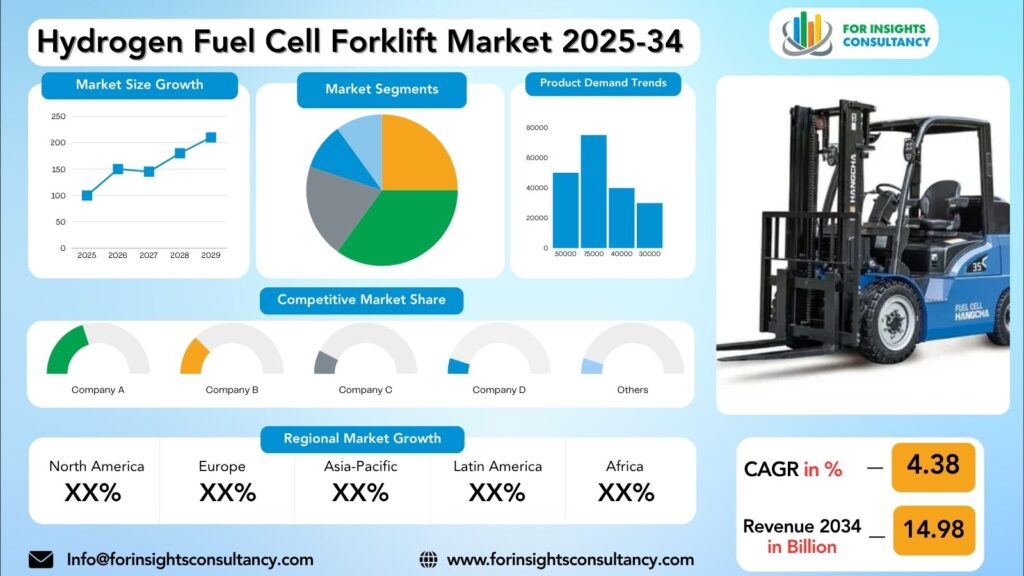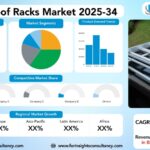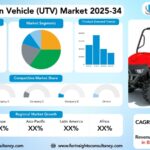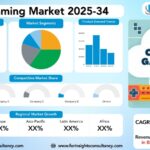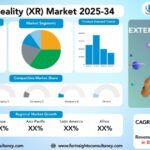Oct-2025 Formats | PDF | Category: Manufacturing & Construction | Delivery: 24 to 72 Hours
Hydrogen Fuel Cell Forklift Market is Anticipiated to increase at a CAGR of 35.29% to reach $17.96 Bn by 2034, recording an absolute increase of USD 9.6 Billion in 2025.
Hydrogen Fuel Cell Forklift Market: A Comprehensive Overview and Future Developments
Hydrogen fuel cell forklifts are becoming very popular in the material handling industry as they are environmentally friendly and operate efficiently. The technology uses hydrogen as a clean energy source, and the electricity is generated by a chemical reaction with oxygen, thus, no emissions are made except water vapor.
It is one of the key advantages of hydrogen fuel cell-powered forklifts to have faster refueling times in comparison with the traditional batteries, thus, the operation will not be stopped, and the productivity will be increased. In addition, these forklifts have longer run times and can maintain their performance even in heavy operations.
Regarding the following steps, the market of hydrogen fuel cell forklifts is very much inclined to quick expansion due to the enhancement in fuel cell technology, wide use of fuel cell-powered vehicles, and impelling of the strict environmental laws. To make fuel cells more efficient and to increase their lifespan, companies are investing in the R&D sector and eventually will lead to the cells becoming more economically viable and of higher quality for the mass commercial use.
First of all, the hydrogen fuel cell forklift market is a potential resource for corporations that want to raise the efficiency of their operations, diminish the release of carbon gases, and follow the sustainability trends before their competitors in the material handling industry.
Market Insights
- In 2024, the Hydrogen Fuel Cell Forklift Market is expected to see significant growth, with the largest revenue share coming from the North America region. The market is projected to expand rapidly, driven by the increasing adoption of hydrogen fuel cell technology in forklifts.
- The U.S. population residing in urban areas is estimated to be around 82%, highlighting the potential market size for urban logistics solutions.
- Within the market segments, the largest revenue share is expected to come from the industrial sector, followed closely by the logistics and warehouse segments.
- This growth reflects the increasing demand for efficient and environmentally friendly material handling solutions in various industries. Overall, the Hydrogen Fuel Cell Forklift Market is poised for strong growth in 2024, with North America leading the way in regional revenue.
Market Dynamics
Trends
- Continued rise in the use of hydrogen fuel cell technology in material handling vehicles such as forklifts, as a result of its green nature and overall.
- The embodiment of green principles as the primary source of energy for the next generation of industrial vehicles has been instrumental to the increase in the use of hydrogen fuel cell forklifts.
- There has been a growth of the network that supports the fueling of hydrogen-powered vehicles, particularly in areas that are characterized by the concentration of industries and activities related to logistics and supply chain management.
- The evolution of the state-of-the-art technologies has had a great contribution to the performance of the fuel cells that use hydrogen in addition to a decrease in maintenance and wear and tear costs of the same type of devices.
- According to a report, the strategic collaborations and relations among the leading market players have increased significantly in recent years enhancing product offerings and market penetration.
- Hydrogen fuel cell forklift market sees accelerated growth regulatory pressure for emission reduction is one of the main reasons behind the market expansion.
- Use of the internet of things and artificial intelligence, in devices that are powered by hydrogen fuel cell, like forklifts, is one of the many recent technological innovations that aim for optimal performance and productivity.
- The appearance of innovative financing models enables small and medium-sized enterprises to adopt hydrogen fuel cell technology in their operations leading to increased uptake of fuel cell forklifts.
- Transition to a circular economy model whereby materials are being recycled and reused is at the core of the move to the reuse of hydrogen fuel cell components.
- There is a continual rise in investments in the research and development aimed at solving the problems of energy efficiency and high cost associated with hydrogen fuel cell-powered forklift trucks.
Growth Drivers
- The adoption of hydrogen fuel cell technology is being largely influenced by the growing concern for sustainability and the environment in the materials handling sector.
- Policies and programs put in place by the government to encourage the use of clean energy solutions like hydrogen fuel cells are resulting in the expansion of the market.
- Innovations are improving the efficiency and output of hydrogen fuel cell-powered forklifts, thus, they are becoming a viable alternative to the traditional ones.
- The need for zero-emission solutions in warehouses and distribution centers is increasing the use of hydrogen fuel cell forklifts.
- The growing knowledge of the advantages of hydrogen fuel cells such as lower operating costs and better air quality is the main reason behind the market growth during the forecast period.
Restraints
High Initial Investment Costs: The requirement of a hefty capital investment in a hydrogen fuel cell technology powered forklift can be a major factor that keeps the potential buyers away.
Limited Refueling Infrastructure: The scarcity of a network of hydrogen refueling stations may limit the use of fuel cell forklifts, thus, the adoption of such technology, in some areas, where certain geographic regions are located.
Technical Challenges: The continued presence of technical problems involving the efficiency and performance of fuel cells may limit the market growth and decrease the adoption rates in 2024 and 2025.
It will be very important to overcome these restrictions if the market for hydrogen fuel cell forklifts is to continue growing and be successful in the upcoming years.
Opportunities
Hydrogen fuel cell technology is increasingly being adopted in forklifts, mainly because of its environmentally friendly and sustainable nature. There is a significant rise in the investments put by the key players to improve the efficiency and performance of hydrogen fuel cell forklifts.
Governments are increasingly supporting and providing more initiatives to encourage the use of clean energy solutions in the material handling sector.
The development of the distribution networks and infrastructure for hydrogen refueling stations is going on to facilitate the widespread use of hydrogen fuel cell forklifts.
The demand for efficient and emission-free material handling solutions in industries such as manufacturing, logistics, and warehousing is increasing. There are partnership and collaboration opportunities to facilitate the innovation and technological advancements in hydrogen fuel cell forklifts.
There is a possibility of saving costs and gaining operational benefits if hydrogen fuel cell forklifts are used in various industrial applications.
Challenges
Infrastructure Development: The scarcity of hydrogen refueling stations and the lack of infrastructure to support the widely use of hydrogen fuel cell forklifts.
Cost Concerns: The major high initial cost that is most often associated with the hydrogen fuel cell technology, include the expenses of fueling infrastructure and maintenance.
Market Competition: Rising competition by other alternative fuel options such as electric forklifts and traditional internal combustion engine forklifts.
Technological Advancements: Technology that changes very fast which consequently calls for continuous research and development activities to be able to stay competitive in the market.
Regulatory Hurdles: Compliance with changing regulations and emission standards that affect the uptake of hydrogen fuel cell forklifts in different areas.
Basically, the Hydrogen Fuel Cell Forklift Market is going to confront enormous challenges in the next years which will hinder its development if such issues are not resolved.
Hydrogen Fuel Cell Forklift Market Top Companies Covered In This Report:
Evaluate The Strategic Positioning And Innovation Pipelines Of Leading Market Companies-From Multinational Enterprises To Disruptive Regional Firms. Understand How Key Players Are Innovating, Expanding, And Capturing Value, And Use Competitive Benchmarks To Plan Your Next Move.
- Toyota
- Hyster-Yale Materials Handling
- STILL GmbH
- Linde Material Handling
- Crown
- Jungheinrich
Hydrogen Fuel Cell Forklift Market Company News 2024 and 2025
Toyota (Toyota Material Handling Europe etc.)
In April 2025, Toyota Material Handling Europe partnered with Plug Power and STEF Group to deploy hydrogen fuel cell forklifts (fuel cell-ready models) at two cold storage distribution sites (in Athis-Mons, France & Torrejón de Ardoz, Spain), including green hydrogen supply and infrastructure.
Hyster-Yale Materials Handling
In April 2025, Hyster-Yale announced a strategic realignment of its Nuvera fuel cell business: scaling back fuel cell R&D (with focus only on higher-powered 125 kW fuel cells for port equipment / large charging applications), while increasing investments in lithium-ion battery modules, battery chargers, energy management and hybrid charging platforms including a variant called “HydroChargeTM”.
Linde Material Handling
Linde MH has implemented a “lighthouse” project at its Aschaffenburg plant in Germany: producing green hydrogen onsite (with its own infrastructure) to power a fleet of 21 fuel cell forklifts used in its internal operations.
Segmented View of The Industry:
The Hydrogen Fuel Cell Forklift Market Is Mapped Through A Multidimensional Lens-Tracking Shifts Across Product Type, Applications, And Geographic Regions. This Segmented Approach Enables Businesses to Localize Their Growth Plans And Align Offerings With The Most Profitable Demand Centres.
Segmentation By Type
- Class 1 (Counterbalanced Trucks)
- Class 2 (Narrow Aisle Trucks)
- Class 3 (Pallet Trucks)
Segmentation ByPower Capacity
- Below 2.5 kW
- 5–5 kW
- Above 5 kW
Segmentation ByEnd Use Industry
- Warehousing and Logistics
- Manufacturing
- Food and Beverages
- Retail and Wholesale
- Automotive
- Chemical
- Others
Segmentation By Application
- Indoor
- Outdoor
Global Geographic Coverage:
The Report Provides In-Depth Qualitative And Quantitative Data On The Hydrogen Fuel Cell Forklift Market For All Of The Regions And Countries Listed Below:
North America
The Hydrogen Fuel Cell Forklift Market in North America is set to grow considerably, as a result of the escalating demand for environmentally friendly and energy-efficient solutions. The regional GDP growth along with the inflation rate are anticipated to have a positive impact on the adoption of hydrogen fuel cell forklifts.
In the U.S., one of the main causes of the market expanding is a government grant which supports the implementation of green tech. The grant makes it more attractive for companies to buy hydrogen fuel cell forklifts, hence their widespread use in different industries.
Industrial warehouses and logistics companies are the major purchasers of hydrogen fuel cell forklifts in North America, whereas e-commerce fulfillment centers are the rapidly expanding channel. Sustainability and ethical sourcing practices are indispensable for consumers in this market, which is a reflection of their increased environmental awareness.
In less developed markets where price and status are the main factors, there is still a significant demand for cost-effective solutions that are compatible with sustainability objectives.
The market of hydrogen fuel cell forklifts in North America is expected to expand noticeably over the next few years. The area is separated into the sub-regions of the United States, Canada, and Mexico, each having the different market trends and possibilities.
Adoption of green technologies and emission regulations in the industries are the factors that are pushing the market in the United States. The rise in demand for hydrogen fuel cell forklifts in Canada can be attributed to clean energy solutions being promoted by the government through various initiatives.
With the manufacturing sector growing, Mexico is getting material handling equipment that is not only efficient but also eco-friendly. The North American region as a whole is going to be a significant player in the global market of hydrogen fuel cell forklifts with an excellent growth potential in the coming years.
Europe
Projected GDP Growth and Inflation Rate are two of the most important factors that will determine the trends of the rapidly changing Hydrogen Fuel Cell Forklift Market in Europe. The expansion of the market is thus the result of a single local driver that cannot be replicated and which differently affects each sub-region. As an illustration, in Germany, the adoption of hydrogen fuel cell forklifts is being very much facilitated by a particular government subsidy directed at the promotion of green technologies.
Generally, these products are sold via specialized industrial equipment suppliers, thus this is the dominant channel. However, direct sales to large manufacturing facilities are the fastest-growing channel. Sustainability and ethical sourcing are the prerequisites for consumers in environmentally conscious countries like Sweden and Norway. Conversely, in emerging markets where price and status are the main factors, e.g., Eastern European countries, affordable solutions are preferred to be given sustainability credentials. The variation of consumer preferences reinforces the significance of customizing strategies according to the distinctive traits of each sub-region.
The adoption of Hydrogen Fuel Cell Forklift Market in Europe is one of the results of the continent’s crusade for eco-friendly and green solutions. The trio of Germany, the UK, and France is a step ahead in embracing hydrogen fuel cell technology for forklifts in their respective industrial sectors. In Germany, the market is influenced by the automotive and logistics industries, while the UK’s emphasis is on the decrease of carbon emissions in warehouses and distribution centers. Whereas France is committing itself first to using hydrogen fuel cells to energize the forklifts in factories of the different sectors. Collectively, Europe’s pledge to cut down on greenhouse gas emissions and switch to clean energy sources is the main reason behind the expansion of the Hydrogen Fuel Cell Forklift Market in these regions and the various sub-regions of the continent.
Asia Pacific
The Asia Pacific hydrogen fuel cell forklift market is expected to grow substantially, which can be attributed to the region’s solid GDP growth and stable inflation rate. In China, the major factor that led to the increase in the use of hydrogen fuel cell forklifts is the clean energy adoption subsidy provided by the government. The main channel for these forklifts in China is through government procurement, while the private sector is the fastest-growing channel.
Japan being a country where consumers demand sustainability and ethical sourcing as must-haves, hydrogen fuel cell forklifts are becoming popular due to the country’s strong focus on environmental conservation. South Korea’s market is influenced by a peculiar media trend that encourages the use of green technologies. In developing markets such as India and Southeast Asia, price and status are still the main factors influencing consumer preferences, however, the shift towards sustainability and localism is slowly happening.
The Asia Pacific region is becoming a major market for hydrogen fuel cell forklifts as a result of the growing emphasis on sustainability and the need to lower carbon emissions. The trio of China, Japan, and South Korea are the ones which by large have been the hiring of the clean energy solutions up to now for their material handling requirements.
In China, the huge industrialization combined with the inclination toward green technology is the main reason for the demand of hydrogen fuel cell forklifts. With the cutting-edge technology and very strict environmental regulations, Japan is equally a significant player in the market.
South Korea is also a very important market in the region with its booming logistics and warehouse industry. In general, the Asia Pacific region is a huge market for the growth of the hydrogen fuel cell forklift market each sub-region being a unique contributor to its expansion.
Middle East and Africa
The booming Hydrogen Fuel Cell Forklift Market in the Middle East and Africa is forecasted to have a significant GDP growth of 4.5% annually, inflation rates are expected to remain steady at 3% on average. The local, non-replicable driver in the area is the region’s governments’ incentives for the promotion of environmental sustainability, especially in the UAE where a subsidy program for hydrogen-based technologies is quite generous.
Most of these forklifts are sold directly to large industrial companies, which is the dominant channel, whereas online sales platforms targeting SMEs, which is the fastest-growing channel, are used. Consumers in the region prioritize sustainability and ethical sourcing, thus product acceptance is a must. Nevertheless, in several emerging markets in the region where price and status lead consumer decisions, a more cost-effective way might be needed to spur adoption.
The Hydrogen Fuel Cell Forklift Market in the Middle East and Africa is expanding rapidly, various sub-regions being very promising in terms of growth. In the Middle East, for instance, Saudi Arabia and the UAE are extensively investing in hydrogen fuel cell technology in forklifts as a result of their strong green commitments and aims to lower carbon emissions. While in Africa, the scenarios of South Africa and Nigeria are similarly progressing, with the demand for hydrogen fuel cell forklifts as sustainable solutions to the conventional usage of diesel-powered equipment rising. Thus, the market in the Middle East and Africa is set to experience a major upsurge over the next several years, which can largely be attributed to the increased awareness of the environmental issues among the public and to the government’s inclination towards the adoption of green technologies.
Frequently Asking Questions
What is the Hydrogen Fuel Cell Forklift market size and growth forecast?
Hydrogen Fuel Cell Forklift Market is predicted to grow from USD 9.6 Billion in 2025 to approximately USD 17.96 Billion by 2034. the industry is estimated to expand at a CAGR of 35.29%.
Who are the key players in the Hydrogen Fuel Cell Forklift market?
The Hydrogen Fuel Cell Forklift Market Includes Major Companies Toyota, Hyster-Yale Materials Handling, STILL GmbH, Linde Material Handling, Crown, Jungheinrich, Others.
What are the current and future trends for Hydrogen Fuel Cell Forklift market?
Current trend: New adoption mainly due to heavier emission standards, the need for zero-emission material-handling in warehousing & logistics, and a world operational situation that shows fast refueling & longer run times vs batteries as advantages. Future trend: More and more cost reductions in fuel cell technology & green hydrogen, development of hydrogen refuelling stations, and more extensive use, including heavier payload classes and hybrid/dual-mode forklifts.
Which regions dominate the Hydrogen Fuel Cell Forklift market?
North America dominates the hydrogen fuel-cell forklift market, followed by Europe, while Asia-Pacific is rapidly growing.
What are the challenges facing the Hydrogen Fuel Cell Forklift market?
Expensive initial investments in fuel cell forklifts, and even more so in the case of hydrogen refueling infrastructure, are the main reasons why small operators shy off from adopting the technologies. Limited supply of hydrogen for refueling coupled with safety and storage concerns are the reasons for the limited deployment of the technology. At the same time, fluctuating availability and prices of hydrogen make the situation less certain.
Valuable Points from Hydrogen Fuel Cell Forklift Market Research Report 2025-2034
- Significant changes in Market dynamics.
- Reporting and assessment of recent industry developments.
- A complete background analysis, which includes a valuation of the parental Hydrogen Fuel Cell Forklift Market.
- Current, Historical, and projected size of the Hydrogen Fuel Cell Forklift Market from the viewpoint of both value and volume.
- Hydrogen Fuel Cell Forklift Market segmentation according to Top Regions.
- Hydrogen Fuel Cell Forklift Market shares and strategies of key Manufacturers.
- Emerging Specific segments and regions for Hydrogen Fuel Cell Forklift Market.
- An objective valuation of the trajectory of the Market.
- Recommendations to Top Companies for reinforcement of their foothold in the market.
Customized Report as per your Business Needs
- Our analysts will work directly with you and understand your needs
- Get data on specified regions or segments, competitor and Vendors
- Data will be formatted and presented as per your requirements
Any Requirement Contact Us: Https://Www.Forinsightsconsultancy.Com/Contact-Us/
Table of Contents
For TOC Contact us: https://forinsightsconsultancy.com/contact-us/


